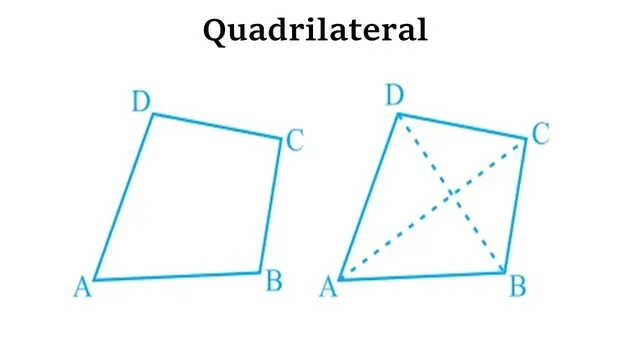Today we will discuss the NCERT solution of quadrilaterals for class 9 in which you will learn important definitions of quadrilaterals and theorems, and exercise solutions of chapter 8 class 9 Maths.
Important Definitions related to Quadrilaterals
1. Quadrilateral – A plane figure bounded by four-line segments is called a quadrilateral. For example, the following is a quadrilateral ABCD where AB, BC, CD, and DA are four sides and ∠A,∠B,∠C, and ∠D are four angles.
2. Vertex – The points of intersection of sides are known as vertices. Here A, B, C, and D are four vertices of the quadrilateral.
3. Diagonal – A line joining opposite vertices is called a diagonal. Here AC and BD are the diagonals of quadrilateral ABCD.
4. Consecutive or adjacent sides – Two sides of a quadrilateral are consecutive or adjacent sides if they have a common point. Here AB, BC, CD, AD.
5. Opposite sides- Two sides of a quadrilateral are opposite sides if they have no common endpoint.
6. Consecutive or adjacent angles- Two angles of a quadrilateral are consecutive or adjacent angles if their common arm is a side of the quadrilateral. For example, ∠A and ∠B are adjacent angles.
7. Opposite sides- Two angels of a quadrilateral are said to be opposite angels if they do not have a common arm. For example, angles ∠A and ∠C are two adjacent angles.
8. Sum of all four angles of a quadrilateral is 4 right angles(360°).
9. Types of Quadrilaterals
Kite – A quadrilateral whose two pairs of adjacent sides are equal is known as a kite.
Trapezium – A quadrilateral whose one pair of opposite sides is known as a trapezium.
Parallelogram – A quadrilateral whose two pairs of opposite sides are parallel and equal is known as a parallelogram. A parallelogram is also a trapezium but a trapezium is not a parallelogram.
Rectangle – A quadrilateral whose opposite sides are parallel and equal and also each angle is 90° is known as a rectangle. A rectangle is also a parallelogram but a parallelogram is not necessarily a rectangle.
Rhombus - A special parallelogram whose each side is equal is known as a rhombus.
Square – A special parallelogram whose all sides are equal and each angle is 90° is known as a square.
10. Note that a square, rectangle, and rhombus are all parallelograms.
i. A square is a rectangle and also a rhombus.
ii. A parallelogram is a trapezium.
iii. A kite is not a parallelogram.
iv. A trapezium is not a parallelogram (as only one pair of opposite sides is parallel in a trapezium and we require both pairs to be parallel in a parallelogram).
v. A rectangle or a rhombus is not a square.
Related Topics
1. Theorem 8.1
2. Theorem 8.2






.webp)
.webp)



No comments:
Post a Comment